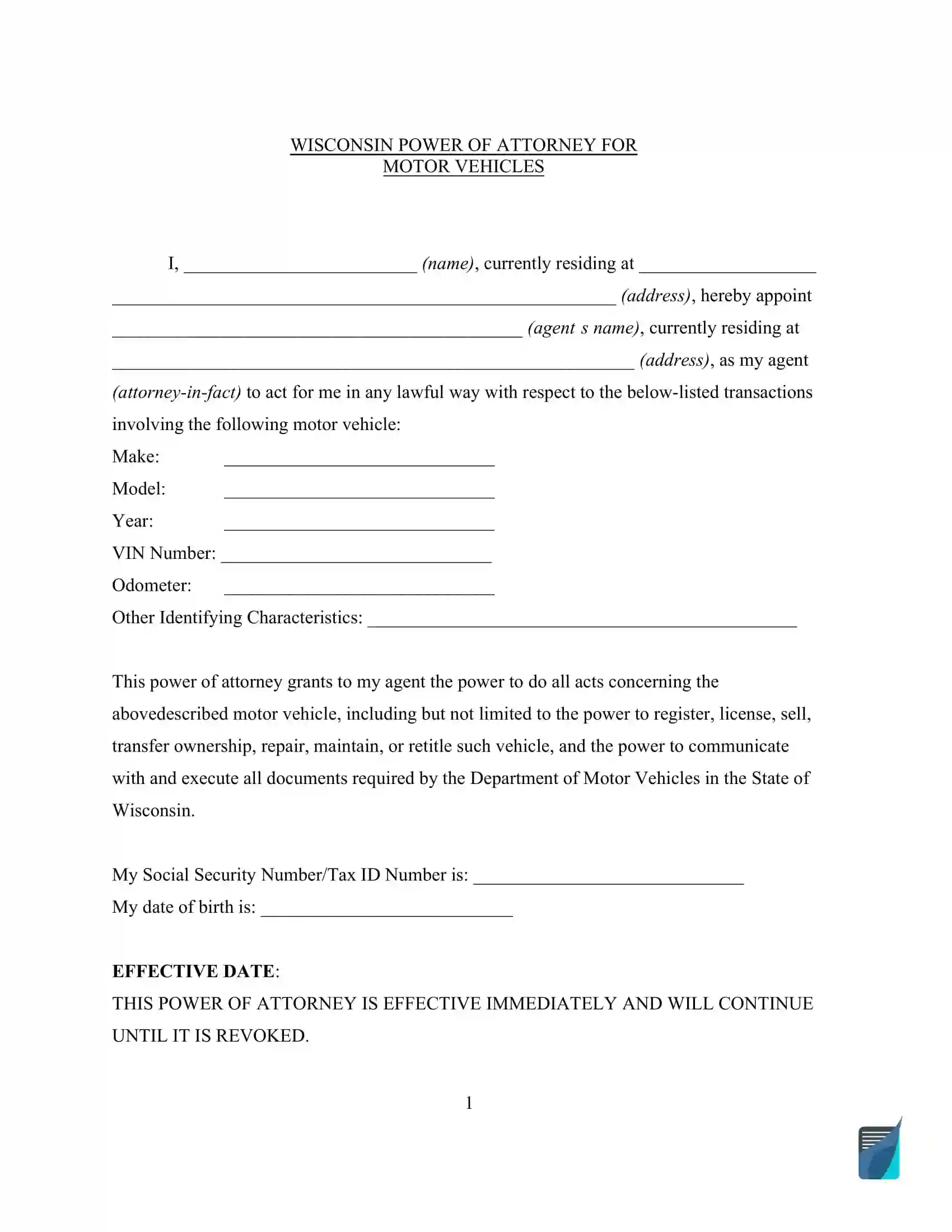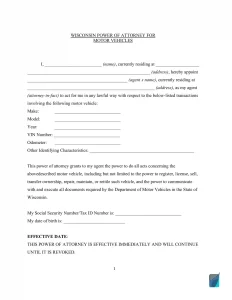Wisconsin Motor Vehicle Power of Attorney Form
The Wisconsin motor vehicle power of attorney allows you to authorize another person to handle specific matters related to your vehicle. This legal document is helpful for transactions that require Department of Motor Vehicles (DMV) interactions, such as registering, buying, or selling a vehicle, especially when the vehicle owner cannot be present.

Build Your Document
Answer a few simple questions to make your document in minutes
Save and Print
Save progress and finish on any device, download and print anytime
Sign and Use
Your valid, lawyer-approved document is ready
When drafting a motor vehicle power of attorney in Wisconsin, the document should include several elements to ensure its validity and effectiveness:
- Principal’s full name and address. This identifies who grants the power of attorney.
- Agent’s full name and address. This specifies who is granted power.
- Vehicle description. Including make, model, year, and VIN.
- Specified powers. Clearly outline what the agent is authorized to do.
- Signature and date. The principal must sign and date the document.
In Wisconsin, under statute 244.05, a power of attorney must be signed by the principal or another individual, if they are at least 18 years old, signing in the principal’s presence and at their direction. For added authenticity, the signature is presumed genuine if acknowledged before a notary public or another officer authorized to take acknowledgments under Chapter 140.
Our power of attorney templates can provide a solid foundation for legally appointing someone to act on your behalf. If you’re specifically looking for state-specific documents, Wisconsin POA forms are tailored to comply with local laws.
Wisconsin Motor Vehicle Power of Attorney Form Details
| Document Name | Wisconsin Motor Vehicle Power of Attorney Form |
| State Form Name | None |
| Relevant Link | Wisconsin Department of Motor Vehicles |
| Avg. Time to Fill Out | 15 minutes |
| # of Fillable Fields | 25 |
| Available Formats | Adobe PDF |
Filling Out Wisconsin Motor Vehicle POA
To correctly complete the Wisconsin motor vehicle power of attorney, follow these detailed steps.
1. Principal Information
Begin by entering your full legal name and current residential address in the designated spaces on the form.
2. Agent Information
Specify the full name and residential address of the person you designate as your agent (attorney-in-fact).
3. Vehicle Information
Detail the vehicle that this power of attorney will cover. Include the make, model, year, Vehicle Identification Number (VIN), the odometer reading at the time of form execution, and any other identifying characteristics that may be relevant.
4. Powers Granted
Carefully review the powers you are granting to your agent. These typically include the authority to register, license, sell, transfer ownership, and handle other vehicle-related activities. Make sure these powers accurately reflect your intentions.
5. Principal’s Additional Information
In the appropriate sections, provide your Social Security Number or Tax ID Number and your date of birth to establish your identity.
6. Effective Date and Duration
Indicate the effective date when the power of attorney will commence, and note that it will continue until you revoke it.
7. Successor Attorney-In-Fact
If applicable, name a successor attorney-in-fact who will assume responsibilities if your initial agent becomes unable or unwilling to serve. Include their full name and address.
8. Signatures
Sign and print your name at the bottom of the form, ensuring you also record the date of signing. This step should be completed in the presence of a notary public.
9. Notarization
The form requires notarization. A notary public will verify your identity, witness your signature, and apply their seal to the document, thereby completing the process.
